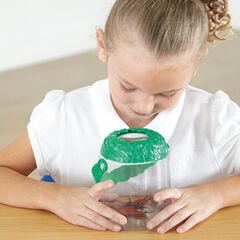Looking at things close up can be really interesting and you will notice things that you have never seen before!
Here are some of our favourite magnifiers and microscopes you could use at home:
- Easi-Scope Microscope
- Rainbow Magnification Viewer pots
- Large Insect Viewing Jar with Magnification
- See and Speak Recordable Magnifying Glass
For any budding scientists, the Flex-View Digital Microscope is one of our best digital microscopes as it can offer 60x and 250x duo focal points, and the magnified images can be captured with a snap shot or video recording. Also the Easi-Scope Microscope is a good choice.
Click here for our full rangeRemember, in all of the activities, what you see and in how much detail will depend on the magnification of your microscope, but have a go and see what you notice.
Activity Ideas
All of these activities support the development of observational skills. Make sure to have lots of fun doing them and encourage children to talk about what they notice.
1. What is it?
Take photos of items using one of our digital microscopes e.g. the Easi-scope, or through a magnifier. Show children the picture and see if they can guess what the object is. Encourage children to look at clues in the picture such as colour, shape and texture.
Here are some we took using the Easi-Scope. Can you guess what they are?

2. Draw what you see
Choose an object and ask your child to draw what they see when looking at the object. Now look at object through a microscope and draw what you see. Look at the two drawings and discuss and compare them. What do you notice? What is the same? What is different?
This is a great way to develop vocabulary and learn lots of interesting words together.
3. Magnification Station!
Set up a magnification station in your home! Collect a range of objects and either magnifying glasses or a microscope. Spend time together looking at objects up close and talk and explore all of the different things. Ask your child lots of questions, for example what do you notice? What do you see? Try to sort the items based on features you notice when up close, such as shapes you can see or patterns.
Tip – Pick some things that look similar without magnification, such as salt and sugar. Look at these through a magnifier and see if they still look the same or if there are differences.
4. Discovery Walk
Take a walk around your home or garden and collect some objects along that way that your child would like to look at in more detail. Use a magnifying glass or microscope to investigate further.
5. Magnificent Materials
Collect a range of different materials including wood, plastic, glass, metal, water etc. Explore these under the microscope. Group the materials in as many different ways as possible, for example with holes, without holes in the material, patterns, texture etc.
6. Body Explorer
Use the Easi-Scope and let your child look at different parts of their body. Look at skin, nails, hair, cheeks, arms etc. What do you notice? Discuss what they see and look at similarities and differences. Trust me, looking at the hairs on your head is fascinating through the Easi-Scope!
Here are some ideas of things to look at through a microscope:
- Things in the kitchen such as salt, sugar, coffee grounds, bread crumbs
- Things outside such as sand, soil, grass, leaves, feathers
- Materials such as sponge, thread, wool, wood, rock
- Things on you such as hair, nails, skin
- Things around the house such as Velcro, coins, a CD
For most children, the more gruesome the better, so a scab can also make interesting viewing!
Please make sure you wash your hands after handling things such as sand, soil, grass etc.
For more learning at home ideas and inspiration click here








